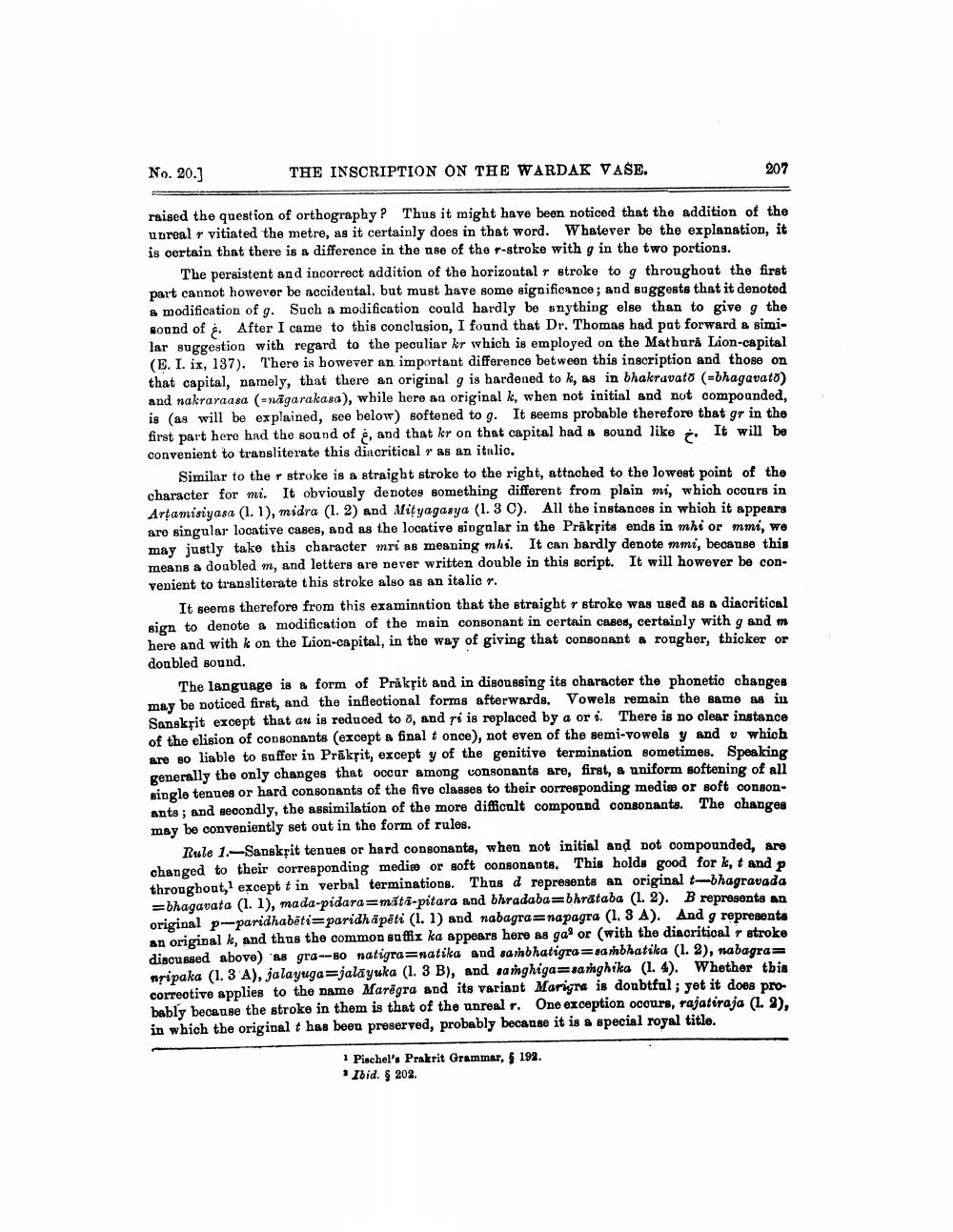________________
No. 20.)
THE INSCRIPTION ON THE WARDAK VASE.
207
raised the question of orthography ? Thus it might have been noticed that the addition of the unrealr vitiated the metre, as it certainly does in that word. Whatever be the explanation, it is certain that there is a difference in the use of the r-stroke with g in the two portions.
The persistent and incorrect addition of the horizontal r stroke to g throughout the first part cannot however be accidental, but must have some significance; and suggests that it denoted a modification of g. Such a modification could hardly be anything else than to give g the sound of į After I came to this conclusion, I found that Dr. Thomas had pat forward a similar suggestion with regard to the peculiar kr which is employed on the Mathura Lion-capital (E. I. ix, 137). There is however an important difference between this inscription and those on that capital, namely, that there an original g is hardened to k, as in bhakravato (=bhagavato) and nakraraasa (=någarakasa), while here an original k, when not initial and not compounded, is (as will be explained, see below) softened to g. It seems probable therefore that gr in the first part here had the sound of , and that kr on that capital had & sound like It will be convenient to transliterate this diacritical r as an italic.
Similar to the r stroke is a straight stroke to the right, attached to the lowest point of the character for mi. It obviously denotes something different from plain mi, which occurs in Artamisiyasa (1.1), midra (1.2) and Mityagasya (1. 3 C). All the instances in which it appears are singular locative cases, and as the locative singalar in the Prakrits ends in mhi or mmi, we may justly take this character mri as meaning mki. It can hardly denote mmi, becanse this means a doubled m, and letters are never written double in this script. It will however be convenient to transliterate this stroke also as an italic r.
It seems therefore from this examination that the straight r stroke was used as a diacritical sign to denote a modification of the main consonant in certain cases, certainly with g and m here and with k on the Lion-capital, in the way of giving that consonant a rougher, thicker or doubled sound.
The language is a form of Praksit and in discussing its character the phonetic changes may be noticed first, and the inflectional forms afterwards. Vowels remain the same as in Sanskrit except that an is reduced to 7, and si is replaced by a ori. There is no clear instance of the elision of consonants (except a final t once), not even of the semi-vowels y and u which are so liable to suffer in Prāksit, except y of the genitive termination sometimes. Speaking generally the only changes that occur among consonants are, first, & uniform softening of all single tenues or hard consonants of the five classes to their corresponding mediæ or soft consonants; and secondly, the assimilation of the more difficult compound consonants. The changes may be conveniently set out in the form of rules.
Rule 1.-Sanskrit tenues or hard consonants, when not initial and not compounded, are changed to their corresponding medis or soft consonants. This holds good for k, t and p throughout, except t in verbal terminations. Thus a represents an original t-bhagravada =bhagavata (1.1), mada-pidara-mata-pitara and bhradaba=bhrataba (1.2). B represents an original p-paridhabēti=paridhāpēti (1.1) and nabagra=napagra (1. 3 A). And g represents an original k, and thus the common suffix ka appears here as ga* or (with the diacritical r stroke discussed above) as gra--80 natigra=natika and sarbhatigra=sambhatika (1.2), nabagra= ngipaka (1. 3 A), jalayuga=jalāyuka (1. 3 B), and sanghiga=sanghika (1. 4). Whether this corrective applies to the name Marēgra and its variant Marigna is doubtful; yet it does probably because the stroke in them is that of the unreal. One exception occurs, rajatiraja (1.3) in which the original t has been preserved, probably because it is a special royal title.
1 Pischel'. Prakrit Grammar, $ 192.
Ibid. 202.




